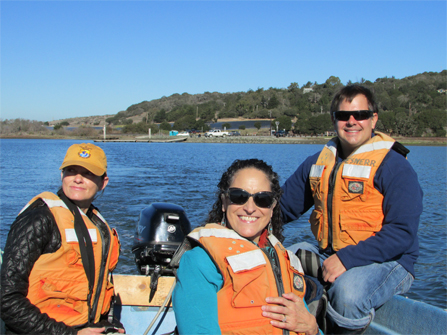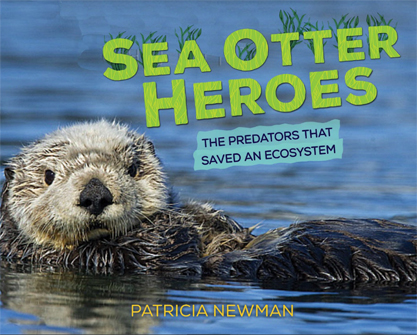"How can I communicate science better?" It's a question we hear often from our members, and from scientists in other fields. SCB talked with author Patricia Newman about the process of writing books with scientists and what scientists can do to improve communication skills. Newman has written several books that connect young readers to scientific concepts, including Sea Otter Heroes: The Predators That Saved an Ecosystem, a Junior Library Guild Selection and recipient of a starred Kirkus review; Plastic, Ahoy! Investigating the Great Pacific Garbage Patch, a Green Earth Book Award winner; and Ebola: Fears and Facts, a Booklist Editors' Choice selection. In fall 2018, Zoo Scientists to the Rescue will be released. Visit her at www.patriciamnewman.com.
1. Why do you think scientists struggle to communicate their research?
When we, in the general public, read or watch the news, we want to know how it affects us. I think the same is true of science. How does this particular discovery affect the way we live our lives? This entrée is often the most difficult part of any communication, and to be successful you have to think like your audience. For instance, children’s authors have to know how to write, but we also have to promote, research, be proficient with many forms of technology, persuade editors to buy our books, and understand the language of contracts. Similarly, scientists wear several different hats, and marketing research for funding or acclaim is a skill that must be developed.
Next, the language scientists use matters. Just like other professions, science has its own vocabulary, acronyms, and buzz words with which most people are unfamiliar. The language of science needs to be translated into something the general population can understand with anecdotes and examples.
Additionally, science experiments usually prove or disprove one discreet concept at a time, but the general public tends to over-generalize and make great leaps in thinking. I know I was guilty of that when I worked with Brent Hughes (a David H. Smith Conservation Research Fellow) and Lilian Carswell on Sea Otter Heroes. The challenge is to pique our interest, yet rein us in at the same time by describing ideas for future research.
2. How does communicating science to children - or through a children's book - help scientists with communication skills?
One of the best ways for children to learn is to teach others. And to teach others, kids have to present the material in an understandable fashion. I believe the same concept applies to scientists explaining their work to a layperson.
I write narrative science, which means my books tell a story. When I speak with scientists, I want to hear their story. Young readers want to be inspired by real scientists and their work. Brent is now a role model for every 4th through 8th grader who reads Sea Otter Heroes.
For the scientists out there reading this, what’s your story?
 |
|
Lilian Carswell (L), me (center), and Brent Hughes (R) on the slough. Photo credit: Elise Newman Montanino. |
3. Can you tell us about the process of writing a book with a scientist?
Brent was an author’s dream. He organized an entire day on the water, introducing me to the Elkhorn Slough estuary and its inhabitants. We made several stops to observe pelicans dive and sea otters groom. We climbed out of the boat into the pickleweed to look at his latest experiment. And he pulled up shoots of seagrass for us to inspect.
The second day we visited his lab. I looked at the wet sink where he processed his samples, the tools in his lab, and his office. I remember we spent a lot of time discussing the best way to illustrate correlation for young readers--a difficult concept for a 4th grader. We finally decided on two graphs (which appear in the book), one comparing seagrass abundance to the El Nino index, and the other comparing seagrass abundance to the number of sea otters in the slough.
The upshot of all this detail is that Brent approached a book about his research in the exact right way. He knew it would take time and a long-range commitment to not only retell his story, but to provide photos and time for editing drafts of the manuscript. I first met Brent in the spring of 2015. I did some advance reading, and finally visited the slough in November 2015. Sea Otter Heroes debuted in early 2017.
4. What is a common concern or apprehension among scientists when working on a book?
Initially, there’s a trust issue—will this author give my research the care and attention it deserves? It’s an understandable worry—scientists have dedicated their lives to their particular fields and here I come promising to make a book for kids. Will it be accurate? Will it include enough detail to be “scientific?” And is Patricia up to the task?
Brent and I met at a David Smith Conservation Fellows retreat, where Chelsea Rochman had invited me to speak about writing for children. Chelsea and I met when I interviewed her for Plastic, Ahoy! Investigating the Great Pacific Garbage Patch. In Brent’s case, I guess I’d already been vetted.
Based on my track record of awards and excellent reviews, I hope scientists can rest easy that I’ll treat their research as if it were my own—because in a sense it is. I have a vested interest in communicating the scientist’s passion and charm as the hero in his/her own story.
 |
5. What have you learned about scientists through the writing process?
Scientists value precision, but it’s often difficult to explain their research to a child using their precise language. I wrote the most technical sections about Brent’s two experiments over and over before I was ready to show them to him. I poured over the different cage designs in his paper and asked so many detailed questions that Brent must have thought I was thick-headed. But it was all in the service of precision.
6. What advice do you have for scientists interested in writing for a younger audience?
I’m asked this question over and over. Without meaning to sound flippant, I’d suggest that the scientist work with a children’s author. Brent earned his Ph.D., knows how to design a mesocosm, and wrote grants for research funding, so I would have a hard time filling his shoes without the same education or skills. Similarly, a children’s author knows the market, has relationships with editors, studies a craft, often has an agent, and visits schools to share her books with her intended audience, so a scientist would have a hard time making the leap without a guide.
Patricia Newman is the author of Sea Otter Heroes: The Predators That Saved an Ecosystem, a Junior Library Guild Selection and recipient of a starred Kirkus review; Plastic, Ahoy! Investigating the Great Pacific Garbage Patch, a Green Earth Book Award winner; and Ebola: Fears and Facts, a Booklist Editors' Choice selection. In fall 2018, Zoo Scientists to the Rescue will be released. Visit her at www.patriciamnewman.com.